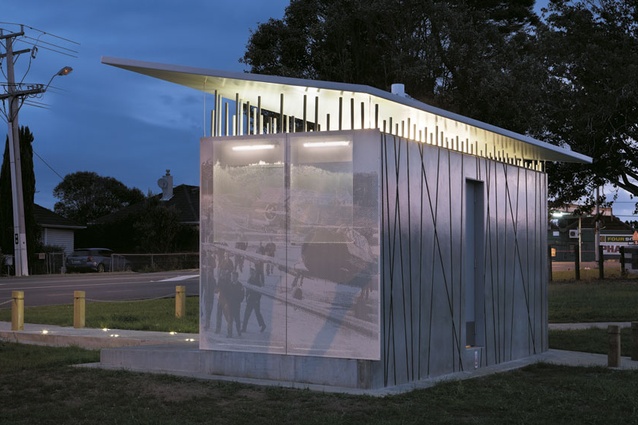Hobsonville toilet block gets a revamp
Archoffice used perforated steel and images of Waitakere's history to revamp the block.
I’ve always maintained what many consider a rather unseemly interest in toilet blocks. To me, plumbing and drainage are fundamental aspects of civic and national infrastructure that, since the Romans, have played a major part in the habitation and civilisation of the globe. It is one of those essentials that we usually forget in our high-minded discussions of architecture. The Romans didn’t make it this far across the globe, of course, but it’s not that long ago that our grandparents were pooing in holes in their back gardens in Ponsonby and Parnell.
I am also, as you would imagine, a fan of the utilitarian World War II memorials of the first Labour government. The people that brought us the welfare state and swathes of state houses also decreed that we would not erect any cenotaphs, arches or statues to remember the dead of that war; we would have community centres and such like instead. So it was a happy coincidence rather than a call of nature that brought me to this new toilet block in the rather sad and run-down Hobsonville War Memorial Park in West Auckland.

West Auckland is not quite the land of the barbarians that the Romans brought their plumbing and drainage to, but apparently the locals sometimes have nothing better to do than stand under a timber beam for a few hours with a cigarette lighter. Consequently, the series of toilet blocks developed by Archoffice for the former Waitakere City Council don’t have a skerrick of wood in their concrete and steel structures. They are assemblies of robust materials under a floating roof containing two toilet cubicles, with their services concealed in a central duct space. Other toilet blocks have varied the basic system by adding such things as planted green walls, but this one in Hobsonville is the best of the lot.
The craft and embellishment here all stem from a tectonic or functional basis, but they are used to leaven the impact of the block: the incisions in the precast units de-emphasise the panel joints and break up the expanse of concrete. The bars below the roof have a functional basis, but because of the hit-and-miss way that they don’t much touch the roof, that plane seems to float more serenely over the structure, like a wing. Most striking is the image on the rain screen that, of course, relates to the air force base history of the area as well as the war-memorial aspect of the park. On closer examination it’s generated by the pixel-like effect of perforations of varying sizes in the stainless steel plate.
Like any good viaduct or sewer, this toilet block still has the strength of the proverbial brick shithouse, but it is leavened with grace and zest as the architects demonstrate some skill and have a bit of fun with what could have been just another prosaic structure. More commode than latrine, these lavatories display the Vitruvian virtues of firmness, commodity and delight. Archoffice have decorated rather than desecrated Hobsonville War Memorial Park.











